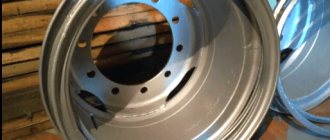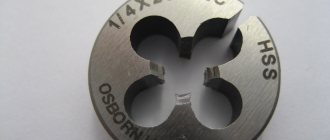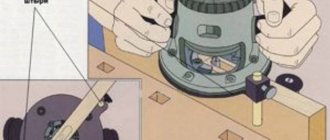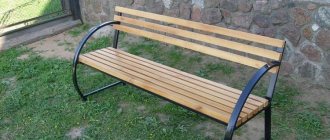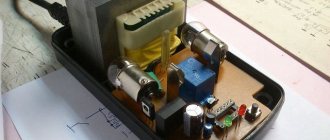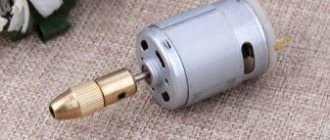DIY knife from a drill
Knife makers have been famous since the times of ancient Rus'. The blood of our ancestors flows in our men, and they are simply unable to stop. Blades are made from any material. A knife made from a drill – paradoxically, this is reality.
Do-it-yourself knife from a drill.
Required materials and tools
The material is not easy to process. People's opinions are divided, but forged steel is definitely more productive in use. Required material:
- wood block;
- masking tape;
- epoxy adhesive;
- motor oil in a container;
- large drill at least 20 mm in diameter;
- stain or oil for wood treatment.
Knife craftsmen are all different. Others prefer to stop at the process of turning the drill and then work with a cutting tool. The quality of the product will be good.
But the decision has been made - we will forge. You will need the appropriate tool:
- anvil, blacksmith's tongs, vice;
- large hammer 4-5 kg, small hammer 1-1.5 kg;
- angle grinder, welding machine;
- grinding and grinding machines;
- oven or forge;
- adjustable wrench;
- sandpaper with different grains;
- drill with a set of drills;
- files will come in handy.
Properties of drill steel
I would like to say about drills that they are classified as high-speed tools. Definitely, the steel is high-strength and refractory. Prepared in production for operation in conditions from 600 to 700 °C. The drill knife has gained popularity among blacksmiths.
Drill marked P6M5.
A product made from it will captivate the owner with its durability and practicality. Don't forget to look at the product label. It will provide a lot of information about the structure of the drill steel. Running material is called material marked P6M5.
The abbreviation indicates the content of tungsten and molybdenum. Professionals consider the ideal grade of steel to be one containing cobalt. A letter with the number “K5” is added to the name.
Manufacturing procedure
Having decided on the materials and steel grade of the future blade, it’s time to get to work and make a knife from a drill. Don’t forget about fireproof gloves and goggles; scale will fly when forging:
- A mandatory process that is rarely mentioned is annealing. During production, the workpiece undergoes hardening; it is necessary to relieve the stress from the metal. After heating the oven to 600-700 °C, you need to put a drill in it and hold the part for 3 hours. Afterwards, let it cool on its own.
- After cooling, the workpiece is ready for use. Heat the oven to 1000 °C and place the drill in it. Having acquired an orange color, the workpiece is heated, we take it out with pliers and clamp it in a vice with the shank. Use a wrench to grab the top of the drill and turn the metal into a straight plane. All movements must be performed quickly - cooling of the workpiece is unacceptable.
- The product cannot be allowed to cool down; by constantly heating it, we begin to forge. Keep an eye on the color of the metal; if it has tarnished a little, put it straight into the oven. We cut it into a strip of the required thickness of 3-4 mm. We extend the shank in length.
- Having reached the desired butt, we begin to work on the tip and blade. We gradually round it in the area where the blade rises, pulling the metal towards the tip. The process is complex and requires certain skills.
- Forging of the RC is carried out with a small hammer; with careful blows, you need to achieve the minimum thickness.
The process of making a knife from a drill.
Finishing
After finishing the forging manipulations, let the blade cool. You should move on to grinding work. We remove carbon deposits and level the slopes. We do preliminary sharpening of the blade. Final works:
- An angle grinder with a cutting wheel will definitely help you adjust the shank to the mounted handle. Mark and cut as required.
- An important stage that gives the blade the quality of hardness and wear resistance is hardening. After heating the workpiece to 500-700 °C, it should be quickly lowered into oil. Be careful - the oil actually splashes and there is a risk of fire.
- Tempering of the blade is mandatory; it should be carried out at a temperature of 200-220 °C for 2-3 hours. Upon completion, the blade should be treated with fine-grained sandpaper.
- We make the handle from a block of wood, drilling holes in it and fitting the shank. It should be given the necessary shape. After making sure that the parts match perfectly, pour epoxy glue into the hole in the handle and hammer the blade with the shank inward. Let the glue dry for a day and treat the handle with oil or special impregnation.
- The final stage is sharpening the blade for finishing. It is preferable to perform these manipulations on diamond stones. The process is long and tedious, but the result is magnificent.
Conclusion
Learning to forge a knife from a drill yourself is not an easy task. There is no need to be afraid to learn. Live and learn. It’s not for nothing that they came up with a saying. We wish you to overcome all the difficulties of this skill and show the whole world the products you made by hand.
PreviousNext
You may also like
Features of steel sharpening
Items obtained from a quick cutter are subject to frequent dulling. And ordinary sharpening wheels, which are made of electrocorundum, will not help improve the quality of sharpening.
Sharpening a knife made of steel R6M5
In order to properly sharpen the tool, cup wheels and flat profiles are used. But, usually, such sharpening has its disadvantages. Therefore, in order to qualitatively sharpen a tool made from this type of metal alloy, two passes are used.
- first, preliminary sharpening is done, for which a wheel with an abrasive surface of grade 40 grain is used;
- for finishing, for which grade zero is used from 25 to 16.
The procedure for forging a knife from a drill at home, materials and tools
Is it difficult to make a knife yourself? If you approach the process correctly, you will end up with a reliable and durable product. It is important to choose the right workpiece material. Metal drills are often used for this; they are almost ideal for forging a knife. Both household models and so-called designer products are made from drills.
Adviсe
What else should you consider when making a knife from a drill? The most common mistake is a blade that is too thin. During processing on a grinding machine or during sharpening, it is likely to break. The optimal blade thickness should be 2-2.5 mm.
It is also recommended that the following conditions be met:
- Holes for attaching the handle can be made by drilling or electrolysis. The latter option is more convenient if the tail section is made of 45 steel.
- To give a good appearance, GOI paste is used.
- As a workpiece, you can use not only a drill, but also a part of a car spring or a file.
Sharpening is best done first with a grinder, and then “finish” the edge of the blade manually with a whetstone.
You also need to remember that according to the law, a knife is considered a bladed weapon with a blade length of more than 90 mm. A double-edged blade of 50 mm or more also requires a permit to carry and store.
This is very important, since the Criminal Code of the Russian Federation provides for measures for the illegal manufacture, storage and carrying of bladed weapons.
Main characteristics
Rapid steels include metal alloys to which additional substances have been added that improve their chemical and physical properties. Thanks to this, the metal alloy becomes strong, wear-resistant, unable to come into contact with oxygen and become covered with rust. R6M5 high-speed steel differs from conventional carbon alloys in that it can process any hard material at high speed, while having good wear resistance.
Microstructure of R6M5 steel
It has unique properties that make it possible to produce tools such as cutters, taps or reamers. Made from this alloy, they will serve the owner faithfully for a very long time.
And the most famous and characteristics of steel grade R6M5 include:
- The hardness of steel grade R6M5 when heated. Typically, other alloys, during long-term and non-stop drilling, begin to heat up, and with increasing temperature, as is known, the metal begins to soften. And the drill loses its abilities and becomes fragile. The same high-speed steel can heat up to 6000 °C, maintaining its initial properties and without losing strength.
- Increased resistance to incandescence at fairly high temperatures.
- Holds an edge very well.
- Has high viscosity.
- Excellent processing on grinding equipment.
- Holds impact loads perfectly.
The characteristics of R6M5 steel listed above make the metal alloy indispensable in construction.
DIY wood carving knife from an old drill - Do it yourself
25.10.2019
Wood carving has centuries-old roots, reflects national traditions and is currently popular. Figurines, panels, and other carved decorations fit perfectly into any interior.
To create amazing masterpieces, professionals do not use super-devices; all the main work is done by ordinary wood carving knives, which, although they have the same shape, differ from each other in size.
A cutter, a Geismus, a cranberry, or maybe a graver – let’s try to figure out which of these tools is suitable for a novice craftsman.
Features and purpose
A product intended for wood carving is an indispensable component of the arsenal of a craftsman who makes decorative objects from natural wood.
The tool differs from a regular kitchen knife in that it has a shortened blade.
When working with wood, a significant load is placed on this part of the tool, so the shorter the metal element is, the lower the likelihood of it breaking under pressure from the cutter.
In addition to the carving itself, there are other options for influencing the wood surface, including sawing, drilling, and gouging. All these operations are performed with other tools and are auxiliary, allowing the carver to fully realize his plan, adding significant elements to the overall picture. The nature of the work determines the choice of the necessary tool.
Kinds
In the arsenal of masters of artistic carving there are a variety of tools - each of these products is intended for a specific type of operation, and may differ in shape, specific sharpening, and functional features. All of them are divided into 3 main types - hand-held, power tools, and devices for machining. Each of them has its own characteristics and advantages.
Manual
Hand tools include numerous knives that differ in design, as well as chisels and auxiliary tools. Tools must be made conscientiously, from high quality steel, in which case they will not crumble or crush the wood. A prerequisite is excellent sharpening, which makes the work of the master easier.
Cutter
The cutter is a universal knife for cutting wood, which is used by all beginners and professional craftsmen. It is used when forming the main part of the product, and then for more delicate work. Its blade is elongated, straight or curved, and the butt is curved.
The main distinguishing feature of the cutter is the sharpening angle of 35˚. A type of product is a European carving knife, one of the most popular and simple models. It has a smooth cutting edge, a curved butt, and an elongated handle. This knife for wood carving allows you to perform various operations - from roughing to the most delicate finishing operations.
A more modern tool is a knife with interchangeable blades of different shapes, which allows you to perform almost any operation on wood. These elements are easily changed using a collet clamp.
Jamb
A jamb knife is the second basic tool of any carver. It is characterized by a cutting angle of 60˚ and a beveled blade shape, which allows significant effort to be applied in the work without the threat of breaking the tip.
Knives for wood carving are convenient for making geometric patterns, roughing and finishing products.
Dimensions can vary significantly, depending on the types of wood used and the specifics of the work performed.
Bogorodsky knife
This tool is shaped like a European carving knife, but its blade is longer and the handle is shorter. It is designed for roughing and fine finishing work. The cutting edge is smooth, the sharpening is partial, the blade size can vary from 3 to 9 cm. The knife got its name from the Bogorodsk carving, its shape is ideal for performing this technique.
Auxiliary Tools
In addition to the tools listed above, craftsmen use a wide variety of devices listed in the table.
| Name | Purpose | Peculiarity |
| Chisels straight and curved | For making recesses, cleaning grooves, chamfering. For contour or relief carving. | The tip can be straight or curved. |
| Klukarzy | For complex ornamentation, creating deep volume. | A flat, semicircular or angular chisel has a short or long curved blade and a neck. |
| Spoon cutters | For making recesses in spoons and other products. | Chisels that have a sharp bend that creates part of a circle. |
| Studs and the like | Used when cleaning the background in hard-to-reach places of flat-relief and three-dimensional carvings. | A knife with a sharpened blade in the shape of a leaf, sword or marigold. |
The auxiliary tools may also include sandpaper of various sizes, rasps, scrapers, and metal brushes. All this will be required for the initial, rough processing of workpieces.
Tool sets
For ease of work, especially for novice carvers, you can purchase a complete set of tools. Products from the same manufacturer include products of the same strength with identical handles. The choice of the composition of the set depends on the specifics of the carving that the master is going to do:
- for garden sculptures you will need chisels, mainly impact ones, hacksaws, large cutters;
- when working on relief paintings, you cannot do without straight and curved chisels and rivets;
- power tools, especially an engraver, are suitable for operations with three-dimensional figures.
When purchasing, you should pay attention to the material of the tool and the manufacturer.
Power tools
This is energy-dependent equipment: engravers - manual and laser, flexible shaft. The first power tool is essentially a lightweight electric drill with a set of 2-6 mm attachments and a chuck for them.
Most models are equipped with a flexible shaft with a collet clamp at the end - this is an analogue of the drill that every dentist's office is equipped with.
The engraver is indispensable for volumetric, relief, and flat-relief cutting.
The flexible shaft can be purchased separately to complement a conventional electric drill, which will allow you to perform carvings of any complexity. The product is equipped with a 1-6 mm cartridge and weighs no more than 1 kg. For example, from TM Bosch you can find 1.25-meter flexible shafts with 3500 rpm.
Modern laser engravers are capable of creating exact copies of finished works or new figures based on the designer’s drawings.
The devices read the shape of the structure, converting it into a digital code, and the actuators already translate it into a finished three-dimensional product. Engravers can process not only wood, but also plywood, plastic, even marble.
The advantages of the device include high productivity, minimal labor costs, and ease of maintenance.
Machining
Planing, jointing and milling machines are used for mechanical processing of wood. Their cutting tools are special knives:
- planing or jointing are metal strips with a sharpened edge and soldered hard alloys;
- milling - metal teeth installed in special holders.
The former are used when processing elongated linear parts, the latter - for creating various recesses, for example, in the manufacture of doors.
Sharpening methods
One of the main criteria for a quality tool is sharpening. If it is done with high quality, working with wood will bring joy to the craftsman, all cuts will go strictly according to the plan.
A knife for wood carving is sharpened like this:
- First, you need to level the working surface of the product using coarse sandpaper or a circle, maintaining the geometric shape of the blade and the sharpening angle.
- After coarse sanding, touch up the coating on the fine-grained surface. When using emery, avoid overheating the metal.
- Proceed to sanding with fine-grained abrasive materials, from more to less grainy, for example, fabric sandpapers 400, 600, 1200.
The final finishing is carried out on felt or leather with a grinding mixture such as GOI paste.
When the cutter begins to chip or crush the wood instead of cutting it in even layers, this is a signal that the tool needs to be sharpened. Using dull knives will require a lot of effort during the work process and can completely ruin the final result.
Position of the chisel when sharpening: 1 – straight chisel; 2 – semicircular and flat; 3 – chisel – corner Position and movement of the tool: a – on straight chisels; b – on semicircular and sloping chisels: 1 – external chamfer; 2 – internal chamfer; c – on corner chisels: 1 – internal chamfer; 2 – external chamfer
Criterias of choice
Currently, we offer the widest range of knives for wood carving, which is represented by products of domestic and foreign production of very different prices. To select the appropriate tools, you need to decide on future tasks - what type of thread will be used, what material will be used.
- To begin with, you can purchase a minimal set - several knives with straight and semicircular cutting edges, then, as you progress, specific tasks will arise, and you can select a tool for them.
- Before purchasing, you also need to consider the main manufacturers, select the size of the knife for wood carving, the grade of steel, the material of the handle, which should be ergonomic, comfortable, and not slip in the hand.
- Among the manufacturers on the market are the following:
- “Tatyanka” is a domestic supplier of high-quality knives with a comfortable beech handle and a blade made of 65G tool steel;
- Flexcut – produces sets of cutters and chisels;
- Frost – produces knives and spoon cutters;
- Dem-Bart – manufactures tools for finishing stocks;
- Narex is a manufacturer of quality kits;
- “Petrov and Son” – produces several types of knives;
- Pfeil - a variety of knives made of the highest quality steel.
Among the variety of products, the final choice can be made by comparing the purpose, quality and cost of the tool.
How to make it yourself
Craftsmen who have worked with ready-made cutting tools see their shortcomings in relation to the technology used.
It could be the length of the blade or its shape, someone doesn't trust the hardening of finished products, or they don't like the configuration and material of the handle. In such cases, you can make a wood carving cutter with your own hands.
To do this, you will need a little experience in handling metal and a fairly simple set of tools:
- blade from a hacksaw or circular saw (2.0 mm thick);
- a piece of wood;
- electric sharpener.
Chemical composition
The chemical composition of R6M5 steel consists of the following metals:
Chemical composition of R6M5 steel and some other high-speed steels
An alloy with the addition of cobalt, namely R6M5K5 steel, has been used since the beginning of the twentieth century. The cobalt content in products made from it is not higher than 15 percent. If they alloy it with vanadium and chromium, then its metallic base only increases. Products such as tools for cutting acid-resistant and heat-resistant metals, falling under the austenitic classification, are made from this steel. While processing such metals with products from another alloy is very difficult. This steel is characterized by increased hardness and heat resistance.
Forging knives at home with your own hands, forging technology
A good knife is a cool, necessary and beautiful thing. A good knife with your own hands is no longer a thing, but a symbol of the person who made it. It’s not easy, but if you set a goal, it’s possible to succeed in forging knives of your own design.
Despite the fact that we are talking about hot forging technology using high-quality alloy steel, preparing work and making a knife are processes that are quite accessible to every person. The main thing is to make a decision.
What is a good knife
First, let's agree on the functional purpose of the knife that you are going to make with your own hands. Most likely, the best choice will be to focus on making a high-quality hunting knife. With hunting knives, we also need clarity: which one is the most versatile?
Forging a knife from a rope.
He will be the most suitable. After analysis and surveys in hunting sources, a description of the average hunter’s knife appeared, which can be considered the most universal.
For Russian hunting conditions, this would be a knife of medium size with the following dimensions:
- The blade can be from 12 to 14 centimeters long, and no more than 3 cm wide.
- The thickness of the blade is approximately 3 - 4 mm.
- The total length of the knife ranges from 23 to 27 centimeters.
Steel and only steel
The choice of metal is limited, or more precisely, you have no choice at all. Only steel for forging knives, no options. Let's figure out what steel is in principle: it is an alloy of iron and carbon. The typical carbon content range in steel is from 0.1% to 2.5%. The higher the level of its content, the stronger and more resistant the steel is to external influences, but it immediately loses its ductility and toughness.
Properties of steel that have the most direct impact on the good quality of the product:
- High wear resistance depends on the hardness of the steel, which in turn depends on the carbon content of the alloy.
- High strength – maintaining the integrity of the product under the influence of external forces.
- Hardness is its resistance to deformation.
- High ductility is the ability of a steel product to bend under the influence of external forces and then restore its shape.
- Red resistance is the resistance of a metal to high temperatures. Hard grades of steel are the most red-resistant.
Forging tools. Blacksmith tool. Scheme of forging a knife Dimensions of a knife for forging. Relief surface on the blade.
It is important that all five indicators are closely interrelated. The more ductile the steel grade, for example, the lower its hardness. The properties of alloys can be controlled using additives and alloying elements.
Now about doping. This is the targeted addition of additives to metal to change various properties for the better. What steel is not alloyed with: nickel, molybdenum, cobalt, etc. We are interested in alloyed tool steel, which has the properties described above. There are many brands of high-quality metals; their characteristics can be found in numerous reference books and manuals.
It is enough for us to understand the general principles in order to find a suitable steel for our knife. You don’t need to go far to get it; a knife is forged from bearings, files, springs, drills and even metal cables. In each case there are technical nuances, but the general rules for forging knives at home are the same and strict.
Forging a knife from a chain.
This is not about beauty, but about the shape of the blade, which must be selected and sketched at the start of the preparatory work. There are few basic forms of blade profiles: dagger, straight spine, profiles with a raised or lowered spine line, finca or bowie, goat leg, tanto.
Let us immediately note that, for example, “tanto” or finka and “bowie” refer to bladed weapons.
R6M5 high-speed steel
R6M5 steel is high-speed and belongs to one of the types of tool steel. It has a high safety margin, which allows it to process hard materials. The operating speed of grinding and drilling devices where it is used is several times higher than the speed of a conventional alloy. This is not the only advantage of high-speed steel, marked as P6M5.
Minuses
The main disadvantage is that due to the low chromium content, the alloy is susceptible to corrosion . The higher the temperature, the faster the destructive processes occur.
- A thin sharp cutting edge , even with slight pressure, leads to damage to soft tissues - a high probability of causing injury, not suitable for tropical fruits with soft skin, hard bone (mango, avocado - risk of bone chips getting into the pulp).
- The quality of sharpening decreases with frequent simultaneous cooling - the sudden release of tungsten energy affects the atoms of other elements of the crystal lattice.
- Loss of sharpening quality when not in use for a long period of time.
- Loss of properties due to prolonged exposure to negative temperatures in an environment with high humidity. reduction of service life due to icing and defrosting. If this happens, gradually defrost it in an oily, non-acidic solution. carefully remove plaque. During the first operation, after getting rid of ice, heat it up gradually.
- Difficulty of manual processing - without turning equipment it is difficult to sharpen the blade yourself.
- When sharpening by hand, it is not recommended to cut shortcrust pastry - one edge crumbles, the other shrinks.
- Contrary to its intended purpose, rapid manual cutting without proper training may result in personal injury . This also applies to work not at a right angle.
- Such knives will not be able to separate products of different densities (fish fillets from bones).
Alloy Application
The positive characteristics of this alloy helped to find the use of this steel in household use. Knives are made from it. Moreover, if the product is sharpened correctly, it will be able to cut not only the flesh of an animal, but also a thin metal plate.
The only disadvantage of this product is its sharpening. But, if you know all the tricks of proper sharpening, then this tool will become very useful in everyday life. These products are most often used by hunters and tourists.
Despite the expensive cost, the use of alloy for knives has become very popular in everyday life.
The global brand for the production of these cutting tools is.
Every man in his house has a power tool, in which drills made of this type of steel are used as auxiliary equipment. The varieties of drills that are made from this R5M6 steel include:
- crown ones, which are used for drywall;
- stepped;
- drills designed for stone, wood or metal.
Not only drills and knives are made from this material. Slotting cutters, hacksaw blades, and countersinks are made from R6M5 steel.
Heat treatment of R6M5 steel
Heat treatment of the R6M5 alloy has a number of subtleties that relate to its properties. The fact is that it is capable of decarbonization during heating. To prevent this from happening, it is usually heated using a slow simmer.
R6M5 high-speed steel heats up to 1230 degrees. During heating, steel mill workers closely monitor the process. During the first warm-up, the temperature rises to two hundred degrees and the heating stops for an hour, then another additional heating is performed to thirty degrees. And again a vacation for an hour. After this, it is continued to be heated to 690 degrees and stopped again for an hour. And the last two heatings are brought to temperatures of 860 and 1230, respectively.
This is a very complex incandescent procedure. Thanks to such hardening, the alloy acquires properties corresponding to it, but its cost, of course, increases.
After heating to 1230 degrees is completed, it is cooled using saltpeter, air and oil. Then, the temperature drops to 560 degrees. This temperature is maintained for one and a half hours. At this time, various alloying elements are added to the steel, which improve its properties. They also give it the appropriate hardness.
Before such long heating begins, the metal alloy is annealed. This is done in order to reduce the fragility of future products while maintaining strength parameters at the proper level.
To improve the characteristics of the properties of this alloy, so that they have good wear resistance, corrosion resistance, and high hardness, nitriding is used. This metal processing is carried out in a gas environment that consists of 80 percent nitrogen and twenty percent ammonia. The time this procedure takes is about forty minutes. The heating temperature will range from 550 degrees to 6600. This hardening will allow the alloy to form a less brittle surface layer.
Such an alloy can be supplemented with another element, namely zinc. Galvanizing occurs in a gas or liquid environment that contains a large amount of zinc. The heating temperature in it corresponds to 5600 degrees. And the time is about thirty minutes.
Source
GOST and TU steel R6M5
R6M5 steel is described by several GOSTs and TUs. Each of them contains products and technical requirements for them. Despite the transition of rolled metal to hard alloys, the characteristics of R6M5 keep this brand in the field of view of many steel foundries. The following products, described by the relevant GOSTs or specifications, are still in demand:
- cold-deformed shaped profiles of high precision TU 14-11-245-88;
- forged circles or squares, assortment - GOST 1133-7;
- hot-rolled wheels - GOST 2590-88;
- calibrated rod - GOST 7417-75;
- rods and strips - GOST 19265-73 (steel grade R6M5K5);
- circles with special surface finishing - GOST 14955-77;
- There are probably still GOSTs that are not included in the list.
Steel R6M5 - composition, characteristics, application, sharpening, processing
R6M5 steel, sometimes called high-speed (high-speed) or self-cutting steel, belongs to the category of tool steels. The presence of alloying elements in this steel, and the decoding P6M5, indicates that its mass volume contains about 6% tungsten and 5% molybdenum. By the way, the letter P shows that this steel is high-speed. There are imported analogues - M2 (USA AISI/ASTM). The marking of imported steels begins with the abbreviation HSS, its decoding sounds like this - high-speed steel.
pros
R5M5 steel for knives has the following advantages:
- Ability to cut hard and heterogeneous materials – cutting bone and cartilage tissue.
- The quality of sharpening is not affected by the cutting speed - a combination of tungsten and carbon - suitable for thin cutting of hard fruits and vegetables (radish, quince).
- Knives made of R6M5 steel practically do not become dull when slicing onions and lemons, which cannot be said about other alloys. After working with these products, immediately rinse under running water and wipe dry.
- The knife does not jump off when cutting wilted products or tendons.
- Durability – high molybdenum content.
- Maintaining blade sharpness at temperatures above 300° C .
- Increased resistance to immediate mechanical impacts, including vibration.
- Easy to clean - there is no need to use special products to clean the blade.
- Fast sharpening on lathe equipment . Possibility to start operation without waiting for the alloy to cool completely.
- The high silicon content minimizes the risk of blade destruction due to acid or alkaline exposure in an environment with low air humidity - the possibility of use for cutting building materials.
- High fire resistance - withstands short-term contact with an open flame - wash off the scale after cooling in natural conditions.
- Lack of diffusion properties - particles of the processed material do not penetrate into the structure of the blade and are easily washed off with running water (molybdenum is ideal for cutting cattle carcasses).
- Easy disinfection of food products when cutting and cutting them - manganese.
- The low weight of the alloy allows you to quickly change the direction of impact, increasing cutting accuracy.
- The stability of the crystal lattice means it can be used to work in low-strength electric and electromagnetic fields.
- Preservation of sharpening quality even with significant simultaneous temperature increases.


